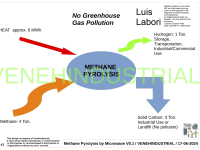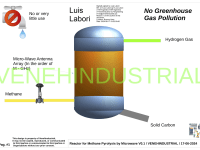For the implementation of decarbonization at the industrial level, it requires the establishment of mechanisms through which environmentally friendly energy sources can be provided. One of these mechanisms is represented by the Electrolysis of Water having as sources of electrical energy from renewable resources (Sun / Wind) plus of course a volume of water (with its corresponding quality parameters) to obtain both oxygen and hydrogen. The necessary volumes of the vital liquid (O2) to obtain one kilogram of Hydrogen are quite representative, being in many cases a prohibitive factor due to the scarcity of such fluid in many regions globally. A feasible option to implement to solve a little weakness in the use of the vital liquid, could be to process the wastewater both urban and industrial through effluent treatment plants so that the result of the process is used in electrolyzers. Taking into consideration the overall cost of all these processes, the generation of hydrogen based on wastewater treatment would be at a marked disadvantage compared to the daily methods of producing hydrogen at the industrial level (methane reforming with steam). This type of pyrolysis is relatively new, so in general it has been little studied. It has a good thermal efficiency (Appleton et al., 2005), the feedstock is supplied by molecular interaction through an electromagnetic field, reduces operating costs and heating time (Fernandez, 2010). But despite these advantages, this type of reactor also has a number of disadvantages, since plastic has a low dielectric constant, so it must be mixed with material with a high dielectric constant. A material such as carbon can absorb the microwave energy and reach the desired temperature, these can raise the air temperature up to 1000 ºC (Hussain et al., 2012).
There are many waste pyrolysis projects that have been implemented but have not been successful for different reasons, such as the low thermal conductivity of the waste or the difficulty of reaching and maintaining high temperatures of the material in a continuous process. Microwave heating technology solves these problems since the microwaves cause the excitation of the molecules present in the organic material, i.e. the heating does not occur by convection. This allows very close control of the heating process.
Microwave induced pyrolysis is, compared to other waste management technologies such as incineration, easily controllable and avoids the emission of toxic components such as dioxins.
Our process is completely enclosed and all products obtained are collected and properly treated without any emissions to the environment. As no oxygen is fed to the pyrolysis process, the gas obtained will be a combustible gas with a high calorific value.
The residue is fed into the reactor and heated to pyrolysis temperature by microwave radiation, releasing a volatile fraction that is separated by condensation into a combustible gas (biogas) and a liquid fraction (bio-oil). So in short, our proposal is the development of a Reactor in which to carry out the Methane Pyrolysis process using Microwave radiation.
Like this entry?
-
About the Entrant
- Name:Luis Labori
- Type of entry:individual
- Patent status:pending





